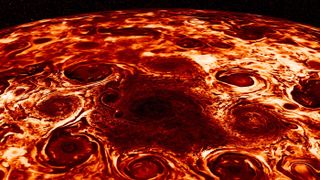Weird Cyclones on Jupiter Form Geometric Shapes — But Why?

Cyclones encircling Jupiter's poles mysteriously arrange themselves in clusters with pentagonal and other geometric shapes, a new study finds.
Ever since Galileo Galilei peered at Jupiter with a telescope in the early 1600s, astronomers have marveled at the dramatic features on the solar system's largest planet, such as its colorful bands and its Great Red Spot. But much has remained unknown about Jupiter's poles, which are not visible from Earth.
Now, visible and infrared images taken by NASA's Juno spacecraft in orbit around Jupiter have revealed giant cyclones arranged in geometric patterns at the planet's poles. For example, at Jupiter's north pole, one cyclone about 2,485 miles (4,000 kilometers) wide has eight cyclones each of similar diameter around it. And at the south pole, one cyclone about 3,975 miles (6,400 km) wide is encircled by five cyclones ranging in size from 3,480 miles to 4,350 miles (5,600 km to 7,000 km).
"We found something completely new that we did not observe before on other planets," study lead author Alberto Adriani, a planetary scientist at the Institute of Astrophysics and Space Planetology in Rome, told Space.com. [In Photos: The Most Powerful Storms in the Solar System]
These cyclones all lasted for at least seven months. In each cluster, the cyclones were close enough to each other to essentially be in contact.

The Juno spacecraft is the first to fly over Jupiter's poles. It passes from pole to equator to pole in about 2 hours, coming as close to about 2,485 miles (4,000 km) above Jupiter's cloud tops.
This isn't the first time astronomers have found giant storms at the pole of a gas giant. Saturn, the second-largest planet in the solar system, possesses a single cyclone at each pole, and the researchers had expected similar findings at Jupiter.
Get the Space.com Newsletter
Breaking space news, the latest updates on rocket launches, skywatching events and more!
"We were wrong, as Jupiter's poles are actually completely different," Adriani said. "From this experience, but also from others, we learned that we have to be very careful in guessing about planets on the basis of previous experiences, as we discovered that our knowledge is often non-applicable."
The scientists detailed their findings in the March 8 issue of the journal Nature. It is one of four studies on Jupiter based on Juno's observations. The other three studies revealed new details on how deep Jupiter's atmospheric stripes run, as well as clues about the planet's gravitational field.
Follow Charles Q. Choi on Twitter @cqchoi. Follow us @Spacedotcom, Facebookand Google+. Original article on Space.com.
Join our Space Forums to keep talking space on the latest missions, night sky and more! And if you have a news tip, correction or comment, let us know at: community@space.com.

Charles Q. Choi is a contributing writer for Space.com and Live Science. He covers all things human origins and astronomy as well as physics, animals and general science topics. Charles has a Master of Arts degree from the University of Missouri-Columbia, School of Journalism and a Bachelor of Arts degree from the University of South Florida. Charles has visited every continent on Earth, drinking rancid yak butter tea in Lhasa, snorkeling with sea lions in the Galapagos and even climbing an iceberg in Antarctica. Visit him at http://www.sciwriter.us
